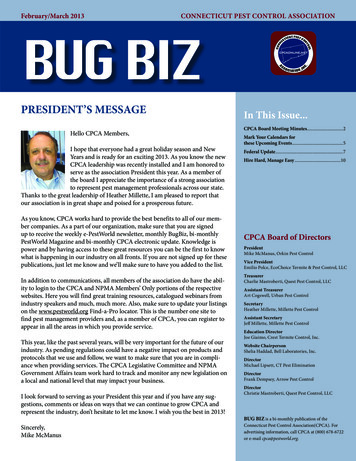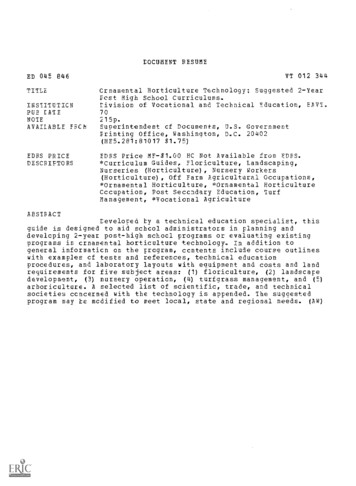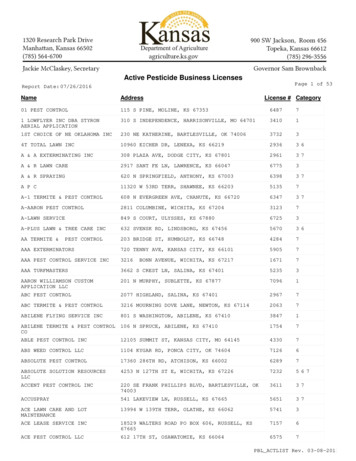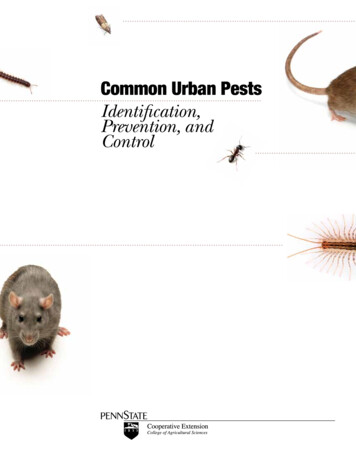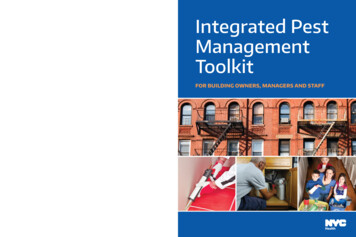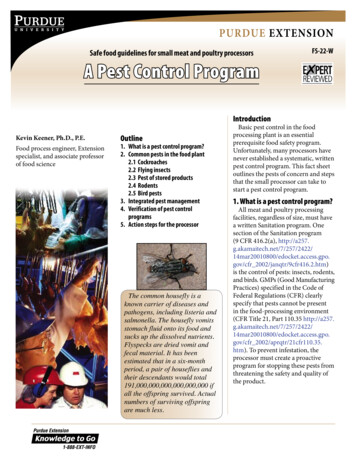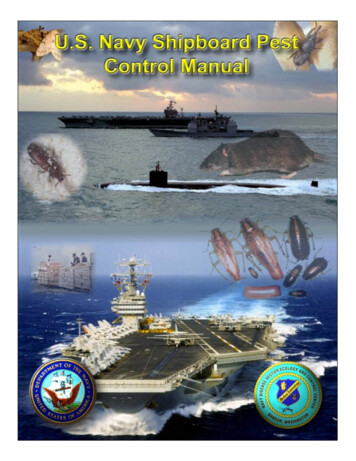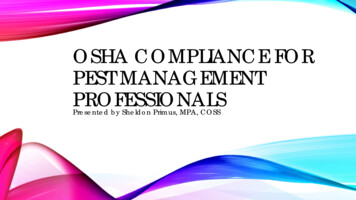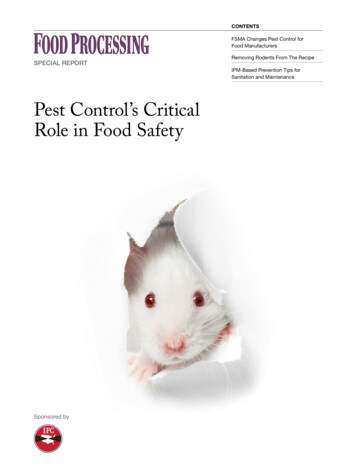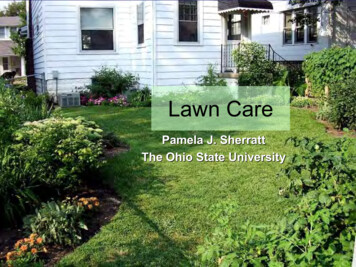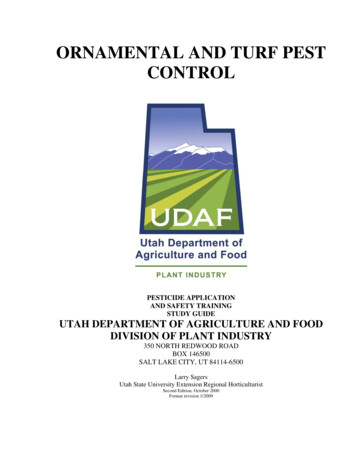
Transcription
ORNAMENTAL AND TURF PESTCONTROLPESTICIDE APPLICATIONAND SAFETY TRAININGSTUDY GUIDEUTAH DEPARTMENT OF AGRICULTURE AND FOODDIVISION OF PLANT INDUSTRY350 NORTH REDWOOD ROADBOX 146500SALT LAKE CITY, UT 84114-6500Larry SagersUtah State University Extension Regional HorticulturistSecond Edition, October 2000Format revision 1/2009
ii
Table of ContentsINTRODUCTION TO PLANT PROBLEMS . VINTEGRATED PEST MANAGEMENT . 1PEST CONTROL SOLUTIONS . 1PESTICIDE BASICS . 2PESTICIDE NAMES . 2PESTICIDE LIMITATIONS . 2PESTICIDE MIXTURES . 3SYSTEMIC PESTICIDES . 3SPRAY ADJUVANTS . 3SOIL FUMIGANTS . 3SEED TREATMENTS . 4PESTICIDE PHYTOTOXICITY . 4PESTICIDE PERSISTENCE. 4MINIMIZING PESTICIDE HAZARDS. 4PLANT DISEASES. 5NONPATHOGENIC DISEASES. 5PATHOGENIC DISEASES. 5INSECTS AND RELATED PESTS . 7COMMON INSECT CHARACTERISTICS . 7PEST MANAGEMENT STRATEGIES . 7WEEDS. 10COMMON WEED FORMS . 10WEED CONTROL. 1010PLANT FORMS AND HERBICIDES.ORNAMENTAL PEST CONTROL. 14WOODY PLANT PEST MANAGEMENT. 14TURF. 15PREVENTIVE MAINTENANCE . 16TURF PEST MANAGEMENT . 16TURF DISEASES. 17TURF INSECTS. 17TURF WEED MANAGEMENT . 18iii
SAFETY . . 19WORKER PROTECTION STANDARD 20GROUND WATER PROTECTION ANDENDANGERED SPECIES 21GLOSSARY . 23CALIBRATION INFORMATION 31ORNAMENTAL AND TURF SUPPLEMENT. 36PATHOGENIC TREE DISEASESNONPATHOGENIC TREE DAMAGETREE INSECTSPATHOGENIC FLOWER DISEASESNONPATHOGENIC FLOWER DAMAGEFLOWER INSECTS AND OTHER PESTSPATHOGENIC TURF DISEASESNONPATHOGENIC TURF DAMAGETURF INSECT PESTSINDOOR PLANT PESTSiv
INTRODUCTION TO PLANT PROBLEMSThe educational material in this study guide is practical information to prepare you to meet the written testrequirements. It doesn’t include all the things you need to know about this pest-control subject or your pest-controlprofession. It will, however, help you prepare for your test.Contributors include the Utah Department of Agriculture and Utah State University Extension Service. This studyguide is based on a similar one published by the Colorado Department of Agriculture. Materials for that guide wereprepared by Colorado State University Extension Service. Other contributors include: University CooperativeExtension Service personnel of California, Kansas, New York, Oregon, Pacific Northwest, Pennsylvania, andWyoming. Other contributors were the U.S. Department of Agriculture -- Forest Service, the United StatesEnvironmental Protection Agency (Region VIII), the Department of Interior -- Bureau of Reclamation, and MetroPest Management.The information and recommendations contained in this study guide are based on data believed to be correct.However, no endorsement, guarantee or warranty of any kind, expressed or implied, is made with respect to theinformation contained herein.Other topics that may be covered in your examinations include First Aid, Personal Protective Equipment (PPE),Protecting the Environment, Pesticide Movement, Groundwater, Endangered Species, Application Methods andEquipment, Equipment Calibration, Insecticide Use, Application, Area Measurements, and Weights and Measures.Information on these topics can be found in the following books:1. National Pesticide Applicator Certification Core Manual, Published by the National Association ofState Departments of Agriculture Research Foundation.2. The Workers Protection Standard for Agricultural Pesticides – How to Comply: WhatEmployers Need to Know. U.S. EPA, Revised September 2005, Publication EPA/735-B-05-002.These books can be obtained from the Utah Department of Agriculture or Utah State University Extension Service.Please contact your local Utah Department of Agriculture Compliance Specialist or Utah State University extensionagent.v
vi
INTEGRATED PEST MANAGEMENTIntegrated Pest Management recognizes a variety ofpest control techniques. IPM considers social,environmental and monetary costs. Interest in IPMmethods is often based on a desire to limit pesticides.However, pesticides are frequently used IPMtechniques. Pests can develop damaging levels ingiven areas year after year. Early treatment controlspests before they cause extensive damage. Beforetreating pests, wait until an economic or aestheticthreshold is reached. These thresholds are used todetermine if controls are needed and when to usethem. The Economic Threshold is the point whendamage justifies the control costs. When pests causedamage, decide whether to initiate control measuresor accept some loss. The Aesthetic Threshold is thepoint when pests cause unacceptable visible damageto ornamental plants.Most landscape IPM programs: Stress plant health to reduce pest losses. Healthy,vigorous plants tolerate or avoid pests. Never usepesticides to compensate for cultural problems. Use sanitation, cultural controls and pesticidescoordinated with natural plant healing or biologicalcontrols. Monitor pest problems to make sound managementdecisions. This detects pest population increases ordeclines allowing treatments to target needed areas.Monitoring gives proper pest control timing. Use IPM techniques to manage pests at acceptablelevels rather than eliminate them. Pests are tolerableif injury levels remains below where control costsexceed threatened damage. In ornamentals, the pestdamage level is often obscured by aestheticconsiderations. Help clients recognize that plant healthrequirements are separate from artificial aestheticrequirements. Injury levels are often so low there isno reason to control pests. Give priority to reducing environmental injury.Environmental management costs are importantconsiderations. Avoid IPM incompatible “insurance” applications.Use preventive applications only if pest injury ispredictable and where options do not exist afterinfestations occur (for example, borers or barkbeetles on high-risk trees).PEST CONTROL SOLUTIONSPlant pest infestations are similar to human illness.Successful treatment follows a sequence of controls.Examine the site and organisms and check thenormal or healthy plant condition. If the plant showssigns of poor health or appears abnormal, look forpossible causes.Identify and assess potential problems, their causesand severity. All organisms on plants are not pests.Some are incidental, others are beneficial. Some pestscause little damage in the beginning, but can becomeserious problems.Determine a control prescription based onexamination identification and assessment. Choosepreventive, curative, or no action. Take no action ifinfestations are not serious, when curative actioncauses more harm than the infestation, or curativetiming is not appropriate. Take no action until pestsare vulnerable.Apply pesticides if they are the best control. Choosethe best chemical and application method. USUExtension Agents, distributors and labels haveadditional control information. Pest problems are notsolved by merely knowing problems and what to doabout them. Apply the prescription correctly.Pesticide applications are the most common pestcontrol intervention.When selecting and using a pesticide consider: Is this pesticide safe where and how is it used? Is the pesticide likely to harm plants beingprotected? Will the pesticide kill beneficial insects or animals? Are pesticide label directions easily understood? When is the best time to use this pesticide? How and to what is the pesticide applied? Is the pesticide registered with the EPA for this use?Evaluate the results Did the prescription work?Base the evaluation on considerations listed above.IPM ControlsIPM uses non-chemical controls when possible tominimize pests. These include:Legal Controls: These keep pests out through legalquarantines, careful plant selection and unwantedintroductions. Eradication programs are usuallyconducted by government agencies to totallyeliminate pathogens from a host area. This is difficultif pests are common in a large area.1
Resistance: Resistant plants are developed throughbreeding, selection and genetic engineering. Totalimmunity is rare, but resistant varieties allow growthin spite of pests.For example, select mildew resistant roses or zinniasSanitation: To prevent pests, remove them, theirfood, shelter, or unhealthy tissue. For example,remove marigolds infected with white mold. Sort,screen, handpick, rogue and destroy affected seeds,nursery plants, and propagation stock.Remove weeds or alternate plants that host viruses orinsect pests. Treat tools with disinfectant to removepathogenic organisms. For example, sterilize prunersafter cutting branches affected with fire blight.Mechanical or physical control: Use insect screens,machines and other methods to control pests or altertheir environment. Avoid bruising plants duringhandling to prevent injuries and reduce infections.Cultural Controls: Healthy plants tolerate injuriesbetter than stressed plants. Plant the right plant in theright location, alter the environment, modify plantconditions, or influence pest behavior to suppress orprevent infestations. This makes pests less likely tosurvive, grow or reproduce. Vary planting or harvesttimes and use good irrigation and fertilizingpractices. Space plants and avoid excessive wateringto suppress crown and stem rot. Use drip or surfaceirrigation to avoid spreading diseases. Plant coolseason crops early to avoid root rot in warm soils.Natural Controls: Pathogenic or non-pathogeniccontrols eliminate most pest problems. In a balancedecosystem, natural enemies control pests. Pestoutbreaks occur when natural controls fail. Typicalnonpathogenic controls are high winds, rain, extremeheat, or freezing temperatures. Cold, wet weatherhelps control insects. Natural pest enemies areeffective in most ecosystems. Predators, parasites anddiseases are important pest controls. Environmentalfactors that diminish their effectiveness include dust,unfavorable weather, biological competitors, drift ofpesticides from adjoining areas or pesticide use on acrop. Host plant defenses are important controls.Insects can be pushed out of feeding wounds intrunks by gums or resins. Leaves and needles can betoxic so pests will not eat them. Leaf coatings preventdisease infections.Biological Controls: These are parasites, predators,or pathogenic organisms that feed on or damagepests. They are introduced by people rather thanoccurring naturally. Biological control advantagesinclude permanence, safety and economy. Onceestablished, they are relatively safe withouthazardous toxicity or environmental pollution.Biological controls are not suitable for all pests.Parasites or predators need time to develop a largeenough population to control pests. This can take toolong to save an endangered crop. It is challenge tofind parasites or predators to introduce.Eliminating secondary parasites of beneficialparasites, protecting beneficials from insecticides anddetermining whether continuous releases are neededare other challenges. Introducing biological controlsin small isolated landscapes is usually not effective.Pesticides: Chemicals control or destroy pests orprevent them from causing damage. Pesticides canattract or repel pests. Plant growth regulators,desiccants, and defoliants are also classified aspesticides although they do not control pathogenicorganisms. Pesticides are only one control method.PESTICIDE BASICSPESTICIDE NAMESThe word “pesticide” can be split into “pest,” “anunwanted organism,” and “cide” meaning “to kill.”The word means “to kill the pest.” Unfortunately, it iserroneously used to describe only insecticides orother products. Saying “pesticides and herbicides” isredundant and incorrect as is saying “pesticides andinsecticides.” Pesticide is an overall term, whileinsecticide is more specific because it controlsinsects, a fungicide controls fungi and a rodenticidecontrols rodents. Other common but improperterminology is to call a product a “weedkiller”instead of an “herbicide.” Since herbicides kill mostplants and not just weeds, it is the preferred term.Likewise, the term “bug killer” refers to products thatcontrol true bugs or members of the insect order,Hemiptera. A true bug killer would not affectgrasshoppers, flies, mosquitoes or beetles or anyother insects that are not true bugs.PESTICIDE LIMITATIONSAll control measures upset the natural balance insome way. Pesticides control pests but have manyside effects.Drawbacks include the following: Development of pest strains resistant to pesticides.2
Temporary controls requiring repeated treatments. Pesticide residues in the harvested crop. Outbreaks of secondary pests, resulting from thedestruction of natural enemies. Undesirable damage to non-target organisms suchas beneficial parasites and predators, fish, birds orother wildlife, pollinators, man, domestic animalsand other plants. Direct hazards in applying pesticides. Specific hazards, formulations and equipment needsthat are covered in the study guide safety section.PESTICIDE MIXTURESPesticide mixtures are designed to do two jobs withone application. Mixtures of fertilizers, insecticides,fungicides and herbicides seem good, but the idea hasdrawbacks. Pesticides and fertilizers are not alwaysneeded in the same place at the same time. Applyingthose pesticides that are not needed wastes moneyand is not an ecologically sound practice. Use thebest pesticide for a specific pest only when it ispresent and causing problems. When using fertilizersand pesticides together, make sure they arecompatible.SYSTEMIC PESTICIDESSystemic pesticides are absorbed by and movedwithin plants. Systemics reach hidden, hard-to-reachpests like fungi that grow inside plants, leaf-curlingaphids, tip moths and leaf mining insects. Common,foliar applied systemics are Bayleton, benomyl andacephate. Soil-applied systemic insecticides includeMetasystox-R, Di-Syston and Furadan. They are usedwhen spray drift is a concern as they are picked up byroots and translocated in the xylem to activelygrowing tissues to control leaf or needle-feedinginsects. They do not usually control scales and borersthat feed on the phloem of woody plant tissues. Mostsoil-applied systemic insecticides are highly toxic,restricted-use pesticides. If pest problems are seriousand spraying is unacceptable, use trunk injections.These are most effective on actively growing treesbefore pest outbreaks are serious. Trunk injectedpesticides inevitably create wounds. To avoidexcessive injury, do not use injections repeatedly.improve pesticide performance. The products includebuffering agents, surfactants and stickers.Buffering agents are used to counteract Utah’s highpH soil and water that increase pesticide breakdownrates. For example, carbaryl (Sevin) hydrolyzes tentimes faster in water of pH 8.0 than in neutral, pH7.0, water. Premature pesticide breakdown reducescontrol and/or in- creases plant injury if spraymixtures are held for several hours before use.Surfactants, or surface-active agents, improve spraydeposition and surface coverage. Treating waxy orhairy leaf surfaces is difficult without surfactants.Injury increases if some surfactants are used onsensitive plants.Stickers: Add sticking agents to improve foliageadherence if rain or irrigation will wash pesticidesoff.SOIL FUMIGANTSSoil fumigation is used before planting to treatpersistent soil organisms. Since fumigation is costly,it is used on high-value crops or where more than onedisease, nematode insect, or weed must be controlled.Almost all fumigants are restricted use pesticides thatrequire special skills licenses. Contact a fumigationspecialist for appropriate fumigant selection andapplications.Fumigation requirements: Tilth: Fumigants are volatile toxins that diffusethrough soil. Cultivate soils to the desired controldepth. Organic matter: Fumigants are actively absorbed byorganic matter. Excess debris reduces effectiveness. Moisture content: Excess moisture blocks fumigantmovement, but most need moisture for best results.Ideal soil is moist enough for seeding but notsaturated. Temperature: Fumigants are most efficient at soiltemperatures of 50-85 degrees F. Waiting Periods: Fumigants are highly toxic.Depending on soil and chemical type, fumigated sitesmust be aerated for days or weeks before seeding.Fumigant UsesSPRAY ADJUVANTSImprove spray performance with additives oradjuvant. They control pH, prevent pesticidehydrolysis, improve coverage, increase retention orNematode control: Rotations of three years or moreusually lowers pathogenic nematodes to levels thatcause little or no economic loss. Where seriousnematode damage is suspected, test soil to see ifnumbers are high enough to justify fumigation.3
Serious nematode damage is rare in Utah except inthe St.George area.Disease control: Treat greenhouses and nursery bedsfor damping off, other seedling diseases orverticillium wilt. Use plastic sheeting for fumigationwith volatile compounds like methyl bromide. Waterseals suffice with some chemicals. Fumigate soilinfested with crown gall, phytophthora or verticilliumwilt before replanting.SEED TREATMENTSFor a more complete discussion, see the UDAF studyguide on seed treatments. Germinating seeds arehighly susceptible to damping off infections thatdestroy seeds and kill young, emerging stems.Chemical treatments protect germinating seeds andyoung seedlings. Most seed-treatment chemicals actonly on the seed surface and nearby soil. Somesystemic chemicals penetrate to kill pathogens withinthe seed and developing seedlings. Pathogens, suchas verticillium and fusarium wilt pathogens, are soilborne. They spread in contaminated soil, cuttings,transplants, tubers, roots and bulbs. Once in the soil,they live for years even without host plants and arealmost impossible to eradicate.PESTICIDE PHYTOTOXICITYPesticide applications that cause plant injuries arephytotoxic. Phytotoxicity creates abnormal growth,leaf drop and discolored, curled and spotted leaves.Severe phytotoxicity kills plants. Phytoxicity causescan be obvious or subtle and mimic insect damage,plant diseases, and poor growing conditions such asinsufficient moisture and improper fertilization.Avoid plant injury when using herbicides. Someherbicides leave residues in spray tanks that injuredesirable plants. Use separate sprayers for herbicides.Phytotoxicity is more severe with certain plants,pesticide drift, pesticide persistence beyond theintended control period and improper applicationrates or techniques.Factors that contribute to pesticide phytotoxicityinclude: High air temperatures during and immediately afterpesticide applications Pesticide drift Excessive pesticide application rates Too little water. Uneven pesticide distribution. Mixing fertilizers with pesticides. Mixing liquids or emulsifiable concentrates (EC)with wet-able powders (WP). WP formulations areless likely to injure plants than EC formulationsbecause they are not dissolved in oil. Using stickers, spreaders, and wetting agents canincrease damage. Variety and species differences. Pesticide mixture incompatibility can producephytotoxicity problems. Incompatibility is likely ifoils, copper or sulfur compounds are included in themix.PESTICIDE PERSISTENCEResidual activity varies greatly among pesticides.Persistence is directly related to application rate, soiltexture, temperature, moisture and other factors.Applicators must be familiar with pesticidepersistence of products where adjacent areas may beaffected, where treated soil is used to grow otherplants, or where humans and pets frequent the area.An example of a persistence problem is using ahighly toxic systemic insecticide on plants just beforethey are sold to the public. While selecting plants,individuals could be exposed to pesticides. Plantsmust not be offered for sale until the chemical haslost its toxicity. The time required is found on thelabel. Successful pest control requires knowing thepersistence period before making applications. Forexample, herbicides used for pre-emergent weedcontrol in turf may persist for 60 to 90 days, andpost-emergent herbicides last from one day to severalweeks.MINIMIZING PESTICIDE HAZARDSTurf and ornamental pesticides are often applied nearhumans, pets, and other domestic animals. They mustnot contact hazardous amounts of pesticides intreated areas. Applicators must be alert to the hazardsand prevent drift to non-target areas.Follow these precautions to avoid problems. Make sure the correct yard is sprayed. Do not allow children or pets to remain in the areabeing sprayed. Check neighbors’ yards to make sure no children orpets can contact spray drift. Remove toys, pet dishes and bird feeders. Remove clothing from the area. Avoid spraying lawn furniture, ponds and birdbaths. Close all house windows. Observe label restrictions for fruits and vegetables. Sweep or rinse away all spray puddles. Secure containers and sprayers before moving.4
If 2,4-D or glyphosate is accidentally sprayed onflowers or shrubs, cut them back immediately to keepit from moving into the root system. Washing off orsprinkling the leaves helps little, and fertilizationintensifies the action.Keep the herbicide away from desirable plants.After using 2,4-D or other herbicides, do not use thesame sprayer to apply insect or disease controls.Residues of herbicides are very hard to wash out, andtiny quantities left in a sprayer can damagesusceptible plants.PLANT DISEASESA disease is anything that interferes with normalplant function. It can be biotic or pathogenic (causedby living organisms) or abiotic or nonpathogenic(caused by physiological disorders). Powdery mildewis a disease caused by a living organism. Irondeficiency is a disease caused by a physiologicaldisorder. A disease is not a condition, it is a process.Infectious organisms, unfavorable weather, ormechanical or chemical injuries cause abnormal plantgrowth.NONPATHOGENIC DISEASESPhysiological disorders from unfavorable weather,mechanical damage, nutrient deficiencies, excesssalts, or toxic chemicals are not caused by pathogens.Most plant diseases are nonpathogenic. These causesdo not grow in nor move from diseased to healthyplants. Pesticides do not cure noninfectious diseases.PATHOGENIC DISEASESOnce an infectious disease starts, the processcontinues until the causal agent or host plant isremoved or environmental conditions prevent itsdevelopment. Pathogens that cause infectiousdiseases grow in plant tissue and disrupt normalphysiological functions. As pathogenic organismsgrow, they produce billions of spores that spread toother plants, causing disease outbreaks. Diseasemanagement reduces or delays epidemics enough tolet plants thrive. Pesticides are designed to stoppathogen growth on or within host plants and toprotect healthy plants. For many pathogens, nochemical treatment is currently available.Infectious Disease DevelopmentInfectious diseases need three conditions to develop: Presence of parasite organisms. Available susceptible hosts. Favorable environmental conditions fordevelopment.Pesticides stop the pathogen development, reducehost susceptibility, or inhibit pathogen developmentwithout changing conditions favorable to the host.Favorable conditions for one disease may beunfavorable for another. Temperature extremes canfavor one disease while inhibiting others. Forexample, white mold damages some annuals underhot, moist conditions, but is less damaging duringcool, dry periods. In contrast, botrytis or gray moldoccurs under moist conditions below 60 degrees F.Moisture extremes affect disease development. Fungiand bacteria prefer wet conditions to enhance sporeproduction and release. Rose rust prefers highhumidity while leaf spot in aspen or fire blight inpears requires free moisture such as dripping dews orsplashing rains to spread. Light, wind, pH, fertilityand soil type influence disease development.Environmental influence is important to diseasedevelopment. For example, sudden temperaturedrops increase susceptibility to fungal cankers.Waterlogged soil increases root rots and moistconditions increase scab and leaf spot. Pathogensmust complete developmental cycles with sporeproduction, dispersal, infection and resting. Somediseases spread slowly to new hosts while othersspread rapidly in a single season. Slow spreadingdiseases produce spores or other inoculum during thegrowing season and disperse them at the season’s endor the beginning of the next season. Diseases thatspread rapidly disperse their inoculum almostcontinuously. Pathogens on a few plants producelarge amounts of inoculum infecting manysusceptible hosts. Pathogenic diseases are caused byfungi, bacteria, viruses, nematodes, parasitic seed5
plants, mycoplasmas and actinomycetes. Fungi,(plural of fungus) cause most plant diseases.Pathogens get nutrients from other organisms.Pathogens living on dead material are saprophyteswhile those that attack live plants are parasites. Mostpathogens mechanically or chemically penetrate planttissue.Diagnosing diseasesDistribution of diseased plants within an areaprovides valuable information for diagnosis. In earlystages, infectious diseases rarely affect large areasbut affect scattered plants or small clusters. Problemsthat occur suddenly and attack different plants aremore likely noninfectious diseases. Diagnosing ordistinguishing diseases by characteristic signs andsymptoms is essential. Signs and symptoms usuallyshow together in diseased plants. Signs areidentifiable pathogen structures that occur withdiseases. They include fungal spores, sporeproducing bodies, bacterial ooze, and parts ofparasitic plants. A hand lens or microscope helpsidentify these. Symptoms are plant diseasereactions. They appear as dead or over- or underdeveloped of tissues. Tissue Death or necroticsymptoms come from degeneration and death of plantparts. Necrosis comes from the Greek word “nekros”meaning “dead body” and means “localized death ofliving tissue.” Necrotic symptoms and theirdefinitions are as follows: Scorch or burn: Sudden death and browning oflarge areas Streaks and stripes: Elongated, narrow, parallelnecrotic lesions associated with leaf veins Net necrosis: Irregular interlocking necrotic lines Blight: Foliage or blossoms suddenly killed bypathogenic organisms Blast: Blighting or sudden death of buds, flowers orfruit Die back: Dying back from tips of twigs orbranches Spot: Circular, dead areas on foliage Shot hole: Dropping out of necrotic tissue fromfoliage, leaving circular holes Pitting: Depressions of dead fleshy tissue underintact skin of fruits and tubers Mummification: Dried, wrinkled, rotted fruits thatstay on the plant Rot: Decomposing dead tissue Canker: Sunken necrotic lesions on stems, tubers orroots Damping-off: Rot at the stem base so the plant fallsover Leak: Soft rot in which juices leak out Bleeding: Chronic flow of sap (often fermented)from wounds Scald: Blanching of surface tissues, giving a pale ordirty brown color Gummosis: Viscous gum which oozes from wounds Resinosis: Abnormal exuding of resinTissue underdevelopment involves stunting, lackof chlorophyll, or incomplete development of plantparts. Their descriptions include: Chlorosis: Lack of chlorophyll or green color as inyellows or mosaics Etoliation: Spindly growth Abortion or atrophy: Halt in development of flowersand fruit Growth Suppression: Complete prevention ofdevelopment of organs Dwarfing, rosetting, etc.: Stunting or tightlysuppressed growthTissue overdevelopment involves galls, swellings,cell enlargement or abnormal multiplication. Theirdescriptions include: Abnormal organs: Development of rudimentary orlatent plant parts Premature growth: Development of
pest control techniques. IPM considers social, environmental and monetary costs. Interest in IPM methods is often based on a desire to limit pesticides. However, pesticides are frequently used IPM techniques. Pests can develop damaging levels in given areas year after year. Early treatment controls pests before they cause extensive damage. Before

